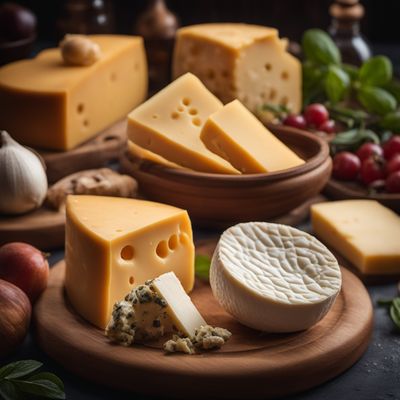
Ingredient
Cheese, bundnerkase
The Alpine Delight
Bundnerkase is a semi-hard cheese made from cow's milk. It has a pale yellow color and a smooth, firm texture. The cheese is aged for several months, allowing it to develop a complex flavor profile with hints of nuts and caramel.
Origins and history
Bundnerkase originates from the canton of Graubünden in Switzerland, where it has been produced for centuries. It is an integral part of Swiss culinary traditions and is often enjoyed as a standalone cheese or used in various dishes, including fondues and gratins.
Nutritional information
Bundnerkase is a good source of protein and calcium. It also contains essential vitamins and minerals, including vitamin A and phosphorus.
Allergens
Bundnerkase may contain lactose, making it unsuitable for individuals with lactose intolerance. It is important to check the label or consult with a cheesemonger if you have any dietary restrictions or allergies.
How to select
When selecting Bundnerkase, look for cheese that is well-aged and has a firm texture. The color should be pale yellow, and the rind should be free from any mold or discoloration. Opt for cheese from reputable producers or specialty cheese shops for the best quality and flavor.
Storage recommendations
To maintain the freshness and flavor of Bundnerkase, store it in the refrigerator in its original packaging or wrap it tightly in wax paper or cheese paper. Keep it away from strong-smelling foods to prevent flavor absorption. Bring the cheese to room temperature before serving to enhance its flavors.
How to produce
Bundnerkase is typically produced by traditional cheesemaking methods, involving the curdling of cow's milk, pressing the curds, and aging the cheese for several months. The process requires specialized equipment and expertise, making it challenging for amateurs to produce at home.
Preparation tips
Bundnerkase can be enjoyed on its own or paired with crusty bread, fruits, or cured meats. It is also commonly used in Swiss cuisine, particularly in fondues, gratins, and traditional dishes such as raclette. Grated Bundnerkase can be sprinkled over pasta, salads, or roasted vegetables for added richness and flavor.
Culinary uses
Bundnerkase is primarily used in Swiss cuisine, where it is a key ingredient in fondues, gratins, and raclette. It is also enjoyed as a standalone cheese and pairs well with fruits, cured meats, and crusty bread.
Availability
Bundnerkase is commonly available in Switzerland and can be found in specialty cheese shops or supermarkets. It may also be available in some international markets or online retailers that specialize in Swiss products.
More ingredients from this category » Browse all

Cheese, oltermanni
The Creamy Delight

Cheese, cream havarti
The Creamy Delight: Havarti Cheese

Cheese, cheshire
The Quintessential British Cheese: Exploring the Delights of Cheshire Cheese

Cheese, tomme de savoie
Savoie's Delight: Exploring the Flavors of Tomme de Savoie Cheese

Cheese, torta del casar
The Creamy Delight: Exploring the Richness of Torta del Casar Cheese

Cheese, nisa
The Hidden Gem of Cheeses: Nisa, a Delightful Culinary Treasure

Cheese, gouda
Gouda: The Golden Gem of Cheeses

Cheese, morbier
Morbier: The Creamy Delight from the Jura Mountains

Cheese, Monterey Jack
Monterey Jack: The Creamy Delight

Cheese, bra
Bra Cheese: A Savory Delight

Cheese, baita friuli
Baita Friuli: A Savory Delight from the Italian Alps

Cheese, saint nectaire
The Creamy Delight of Saint Nectaire Cheese
